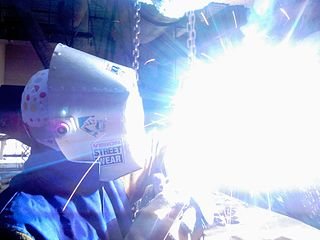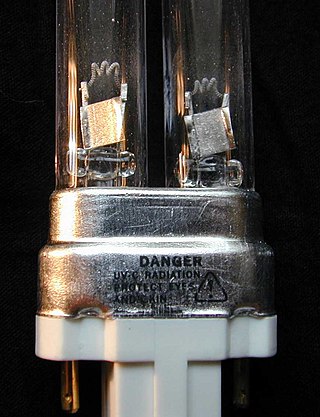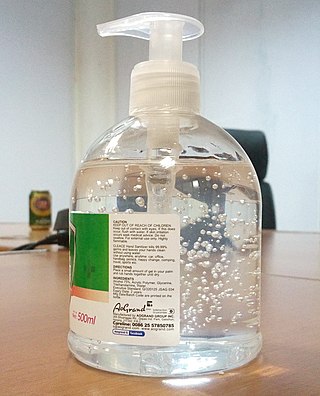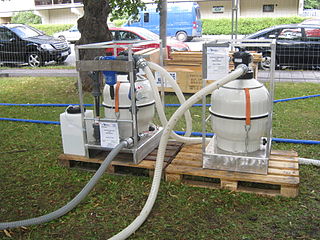Related Research Articles

Ultraviolet (UV) is a form of electromagnetic radiation with wavelength shorter than that of visible light, but longer than X-rays. UV radiation is present in sunlight, and constitutes about 10% of the total electromagnetic radiation output from the Sun. It is also produced by electric arcs, Cherenkov radiation, and specialized lights, such as mercury-vapor lamps, tanning lamps, and black lights. Although long-wavelength ultraviolet is not considered an ionizing radiation because its photons lack the energy to ionize atoms, it can cause chemical reactions and causes many substances to glow or fluoresce. Many practical applications, including chemical and biological effects, derive from the way that UV radiation can interact with organic molecules. These interactions can involve absorption or adjusting energy states in molecules, but do not necessarily involve heating.

A toothbrush is an oral hygiene tool used to clean the teeth, gums, and tongue. It consists of a head of tightly clustered bristles, atop of which toothpaste can be applied, mounted on a handle which facilitates the cleaning of hard-to-reach areas of the mouth. They should be used in conjunction with something to clean between the teeth where the bristles of the toothbrush cannot reach - for example floss, tape or interdental brushes.

Sterilization refers to any process that removes, kills, or deactivates all forms of life and other biological agents such as prions present in or on a specific surface, object, or fluid. Sterilization can be achieved through various means, including heat, chemicals, irradiation, high pressure, and filtration. Sterilization is distinct from disinfection, sanitization, and pasteurization, in that those methods reduce rather than eliminate all forms of life and biological agents present. After sterilization, an object is referred to as being sterile or aseptic.

A disinfectant is a chemical substance or compound used to inactivate or destroy microorganisms on inert surfaces. Disinfection does not necessarily kill all microorganisms, especially resistant bacterial spores; it is less effective than sterilization, which is an extreme physical or chemical process that kills all types of life. Disinfectants are generally distinguished from other antimicrobial agents such as antibiotics, which destroy microorganisms within the body, and antiseptics, which destroy microorganisms on living tissue. Disinfectants are also different from biocides—the latter are intended to destroy all forms of life, not just microorganisms. Disinfectants work by destroying the cell wall of microbes or interfering with their metabolism. It is also a form of decontamination, and can be defined as the process whereby physical or chemical methods are used to reduce the amount of pathogenic microorganisms on a surface.
A water dispenser, known as water cooler, is a machine that dispenses and often also cools or heats up water with a refrigeration unit. It is commonly located near the restroom due to closer access to plumbing. A drain line is also provided from the water cooler into the sewer system.

Dishwashing, washing the dishes, doing the dishes, or washing up in Great Britain, is the process of cleaning cooking utensils, dishes, cutlery and other items to prevent foodborne illness. This is either achieved by hand in a sink using dishwashing detergent or by using a dishwasher and may take place in a kitchen, utility room, scullery or elsewhere. There are cultural divisions over rinsing and drying after washing.

A hospital-acquired infection, also known as a nosocomial infection, is an infection that is acquired in a hospital or other health care facility. To emphasize both hospital and nonhospital settings, it is sometimes instead called a healthcare–associated infection. Such an infection can be acquired in hospital, nursing home, rehabilitation facility, outpatient clinic, diagnostic laboratory or other clinical settings. Infection is spread to the susceptible patient in the clinical setting by various means. Health care staff also spread infection, in addition to contaminated equipment, bed linens, or air droplets. The infection can originate from the outside environment, another infected patient, staff that may be infected, or in some cases, the source of the infection cannot be determined. In some cases the microorganism originates from the patient's own skin microbiota, becoming opportunistic after surgery or other procedures that compromise the protective skin barrier. Though the patient may have contracted the infection from their own skin, the infection is still considered nosocomial since it develops in the health care setting. An easy way to understand the term is that the infection tends to lack evidence that it was incubating, or present when the patient entered the healthcare setting, thus meaning it was acquired post-admission.
An antimicrobial is an agent that kills microorganisms (microbicide) or stops their growth. Antimicrobial medicines can be grouped according to the microorganisms they act primarily against. For example, antibiotics are used against bacteria, and antifungals are used against fungi. They can also be classified according to their function. The use of antimicrobial medicines to treat infection is known as antimicrobial chemotherapy, while the use of antimicrobial medicines to prevent infection is known as antimicrobial prophylaxis.

A germicidal lamp is an electric light that produces ultraviolet C (UVC) light. This short-wave ultraviolet light disrupts DNA base pairing, causing formation of pyrimidine dimers, and leads to the inactivation of bacteria, viruses, and protozoans. It can also be used to produce ozone for water disinfection. They are used in ultraviolet germicidal irradiation (UVGI).
Infection prevention & control is the discipline concerned with preventing healthcare-associated infections; a practical rather than academic sub-discipline of epidemiology. In Northern Europe, infection prevention and control is expanded from healthcare into a component in public health, known as "infection protection". It is an essential part of the infrastructure of health care. Infection control and hospital epidemiology are akin to public health practice, practiced within the confines of a particular health-care delivery system rather than directed at society as a whole.

Hand sanitizer is a liquid, gel or foam generally used to kill many viruses/bacteria/microorganisms on the hands. In most settings, hand washing with soap and water is generally preferred. Hand sanitizer is less effective at killing certain kinds of germs, such as norovirus and Clostridium difficile, and unlike hand washing, it cannot physically remove harmful chemicals. People may incorrectly wipe off hand sanitizer before it has dried, and some are less effective because their alcohol concentrations are too low.

Portable water purification devices are self-contained, easily transported units used to purify water from untreated sources for drinking purposes. Their main function is to eliminate pathogens, and often also of suspended solids and some unpalatable or toxic compounds.

Ultraviolet germicidal irradiation (UVGI) is a disinfection method that uses short-wavelength ultraviolet light to kill or inactivate microorganisms by destroying nucleic acids and disrupting their DNA, leaving them unable to perform vital cellular functions. UVGI is used in a variety of applications, such as food, surface, air, and water purification.
Swimming pool sanitation is the process of ensuring healthy conditions in swimming pools. Proper sanitation is needed to maintain the visual clarity of water and to prevent the transmission of infectious waterborne diseases.
An air sanitizer is a sanitizer that acts on airborne microbiological organisms or microorganisms. In the United States, a sanitizer is a disinfectant that is intended to disinfect or sanitize, reducing or mitigating growth or development of microbiological organisms including bacteria, fungi or viruses on inanimate surfaces in the household, institutional, and/or commercial environment and whose labeled directions for use result in the product being discharged to publicly owned treatment works (POTWS).

Solar water disinfection, in short SODIS, is a type of portable water purification that uses solar energy to make biologically-contaminated water safe to drink. Water contaminated with non-biological agents such as toxic chemicals or heavy metals require additional steps to make the water safe to drink.

Oral-B is an American brand of oral hygiene products, including toothpastes, toothbrushes, electric toothbrushes, and mouthwashes. The brand has been in business since the invention of the Hutson toothbrush in 1950 and in Redwood City, California.
The Catskill-Delaware Water Ultraviolet Disinfection Facility is a 160,000-square-foot (15,000 m2) ultraviolet (UV) water disinfection plant built in Westchester County, New York to disinfect water for the New York City water supply system. The compound is the largest ultraviolet germicidal irradiation plant in the world.
Silane-Quats are a class of antimicrobial developed by Dow Corning and first patented in the United States in February 1971 . Subsequent patents were filed throughout the 1970’s by Dow Corning for utilizing its silane-quat as an effective antimicrobial. In doing so, Dow Corning had invented a durable, non-leaching, persistent, surface bonding antimicrobial effective against a wide range of unicellular microorganisms on a variety of surfaces.

Ozonia is a multinational water treatment equipment manufacturer headquartered in Zürich, Switzerland.
References
- ↑ "Best Ways to Disinfect Toothbrush, Toothbrush Sanitizers and Sterilizers – Worldental.Org". Worldental.Org. 2009-11-27. Retrieved 2017-04-26.